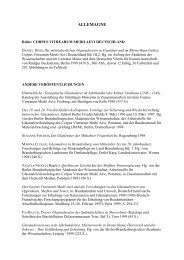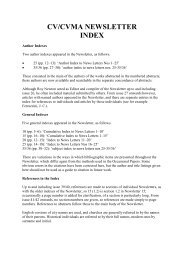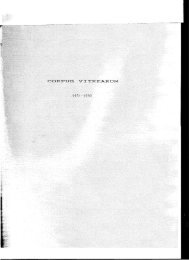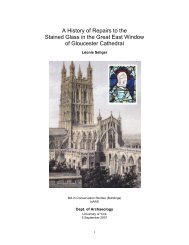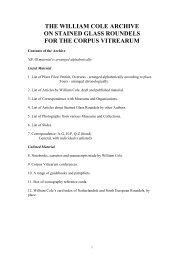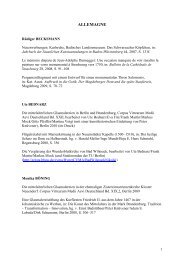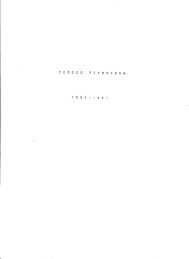BristolConference - Corpus Vitrearum Medii Aevi
BristolConference - Corpus Vitrearum Medii Aevi
BristolConference - Corpus Vitrearum Medii Aevi
You also want an ePaper? Increase the reach of your titles
YUMPU automatically turns print PDFs into web optimized ePapers that Google loves.
chapels around the choir.The upper parts of the<br />
choir elevation were rebuilt, with large<br />
Decorated traceried windows, and an elaborate<br />
lierne vault was inserted. Decorated windows<br />
were also introduced into the older parts of the<br />
church. This work progressed rapidly, thanks to<br />
Hugh Despencers prodigious wealth, and can<br />
probably be assigned to the period between his<br />
acquisition of the Clare inheritance in 1317and<br />
his fall from power and execution in 1326.<br />
Thereafter building works must either have<br />
ceased or drastically slowed down as the monks<br />
lost the financialsupport of their principal patron.<br />
THE STAINEDGLASS<br />
The Choir Clerestory<br />
Nothing is known of the glazing of the<br />
demolished Lady Chapel. The surviving<br />
medieval stained glass is concentrated in the<br />
seven choir clerestory windows (I, NIl-NI V<br />
and SII-SIV), with a window in the sacristy<br />
containing ex situ medieval fragments,<br />
assembled in 1924.<br />
Date and Patronage. Detailed antiquarian<br />
descriptions of the lost heraldry in the glass<br />
allow the planning of the glazing scheme to be<br />
placed in the period c.1338--40. The arms of<br />
England in the ancient form (Gules three lions<br />
passant gardant Or) place the scheme before 1340,<br />
when King Edward III adopted the arms of<br />
England quartered with those of France. The<br />
inclusion of the arms of Montague and<br />
Grandison (formerly in SIll) referred to the<br />
marriage of Hugh Despencer (son of Eleanor de<br />
Clare and Hugh Despencer) to Elizabeth<br />
Montague, daughter of William de Montague,<br />
Earl of Salisbury, and Katherine de Grandison.<br />
The exact date of this marriage is not known, but<br />
cannot have been earlier than the late summer of<br />
1338, following the death of Elizabeth's first<br />
husband. The arms of Hastings (Or a maunch<br />
Gules, formerly in SII) were changed to a<br />
quartered form after Laurence Hastings was<br />
created Earl of Pembroke in February 1339.<br />
This makes the scheme a close contemporary of<br />
the choir clerestory glazing of Wells Cathedral<br />
and the west window of YorkMinster.<br />
The inclusion of figures of both of Eleanor de<br />
Clare's husbands, Hugh Despencer (NIV) and<br />
William la Zouche (SIV), has long supported<br />
the suggestion that the windows were her gift.<br />
She has been identified as the kneeling female<br />
figure in the base of the east window (right<br />
side). There are, however, grounds for<br />
questioning this interpretation. Eleanor died in<br />
June 1337 (William had died in February of the<br />
same year) and the heraldry suggests that the<br />
scheme was not planned until the following<br />
year. There is also reason to believe that the<br />
figure of the female 'donor' may not have been<br />
made for its present location.<br />
Iconography. East Window. The scheme is<br />
dominated by the depiction of the Last<br />
Judgement in the east window. The figure of<br />
Christ the Judge (3c-4c) displaying his wounds<br />
is accompanied by the Virgin Mary (3b-4b) on<br />
his right hand. She bares her breasts to her son<br />
in a gesture of intercession. St John the Baptist,<br />
commonly represented on Christ's left hand, is<br />
included in a group ofApostles in panels 3a--4a.<br />
This position is occupied rather by the restored<br />
figure of St Michael. It is clear from antiquarian<br />
descriptions and pre-restoration drawings that<br />
this figure originally held the arma chrisii, an<br />
extremely early example of this subject in<br />
English monumental painting. The general<br />
resurrection and the separation of the Blessed<br />
and the Damned occupies the base of the<br />
window. Panel 2e contains the kneeling figure<br />
of a naked woman, traditionally identified as<br />
Eleanor de Clare. Panels la-le contain restored<br />
shields of arms (Tewkesbury Abbey, Despencer,<br />
England, D'Amory and Munchesni). The<br />
emphasis on the display of Christ's wounds in<br />
this window may have been suggested by the<br />
presence of an attested relic of the Holy Blood<br />
at nearby Hailes Abbey, which was also a<br />
source of architectural inspiration. The tracery<br />
contains the Coronation of the Virgin Mary,<br />
surrounded by angel musicians.<br />
NIl, NIII, SII, SIll. Each window contains a<br />
figure of a king in the centre light, flanked by<br />
four figures of prophets. Each one was<br />
originally identified by a label in Lombardic<br />
script, of which very few have survived. Each<br />
figure stands under a canopy. Shields of arms<br />
once filled panels la-le in each window. The<br />
tracery is filled with foliage.<br />
NIV and SIV. These are the best known of the<br />
Tewkesbury windows, depicting eight figures<br />
of knights in full armour. They represent the<br />
principal secular benefactors of the abbey and<br />
can be identified from their heraldic surcoats. In<br />
NIV - Robert FitzRoy first Earl of Gloucester<br />
(d.1147), Gilbert de Clare, Earl of Gloucester<br />
and Hertford (d.1230), Hugh Despencer the<br />
Younger (d.1326) and Robert FitzHamon<br />
(d.ll07). In SIV, Richard de Clare, Earl of<br />
Gloucester and Hertford (d.1262), William la<br />
Zouche, Lord of Richard's Castle (d.1337),<br />
Gilbert de Clare, Earl of Gloucester and<br />
Hertford (d.1295),and Gilbert de Clare, Earl of<br />
Gloucester and Hertford (d.1314).<br />
40



